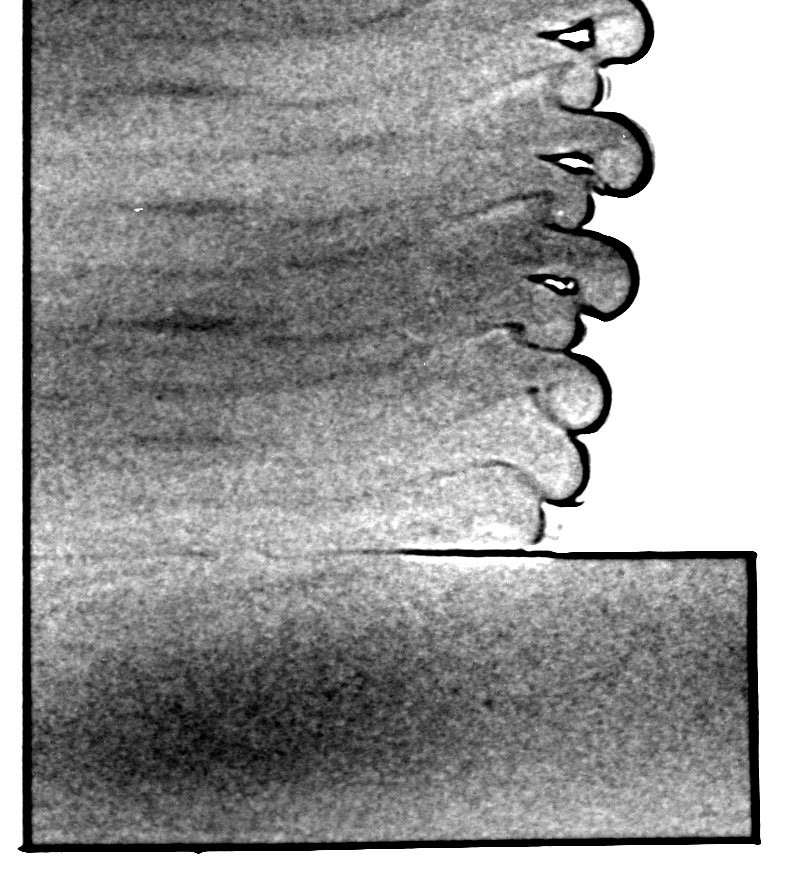Nondestructive Evaluation (NDE)
Neutron interferometry with a laboratory neutron generator and developing high energy X-ray optics.
Building the World’s First Time-of-Flight Laboratory Neutron Imager
Neutron NDE

Evidence of layering in an aluminum AM test coupon as imaged with neutron interferometry at ORNL, April 2022. The Refined Imaging scientists built the ORNL HFIR CG-1D interferometer.
In a DOE SBIR project, Refined Imaging and Adelphi Tech are partnering to build the world’s first time-of-flight imaging system. A pulsed deuterium-deuterium neutron generator by Adelphi is paired with Refined Imaging’s optics for NDE of difficult parts, AM parts too thick for conventional X-ray NDE or lacking X-ray contrast.
It will have:
- A pulsed neutron generator, 10 µs pulses at 1 kHz.
- A gated detector with time-of-flight imaging of fast and thermal neutrons. Gamma ray imaging is also possible.
- Neutron interferometry with large field-of-view optics.
A spin-off project, a small-angle neutron scattering instrument, is being developed with the same source and detector, and with funding from a DOE STTR project.
Enabling Imaging Up to Sub-Micron Resolution
Nondestructive Evaluation (NDE) X-ray & Neutrons
Current NDE technology has a resolution of ~50 microns, but Refined Imaging technology can image to sub-micron resolution. Refined Imaging has developed high-aspect-ratio microfabricated optics using a combination of deep-reactive ion etching of silicon wafers, infilling with metal nanoparticles, and precision stacking of multiple units. These fabrication methods for gratings and data analysis algorithms will increase the available X-ray energy from less than 100 kVp to 450 kVp (necessary to image titanium and steel components). These smaller period gratings will increase the current technology of 50-micron image resolution to submicron image resolution, necessary for porosity and delamination inspection.
The fast and thermal neutron interferometer that Refined Imaging and Adelphi Tech are building in Baton Rouge is arguably the world’s best fast/thermal neutron imaging system. It will have (1) a pulsed neutron generator, (2) a gated detector with time-of-flight imaging of fast and thermal neutrons, and (3) interferometry with large field-of-view optics. The optimal fraction of fast neutron and thermal neutron imaging is a key factor in designing a neutron interferometer optimized for additive manufacturing.
The anticipated benefit is for customers with additively manufactured titanium, steel, or Inconel parts longer than 5-10 cm along the imaging path. The transmission of fast and thermal neutrons through these thicker materials is superior to X-rays. The thermal neutron wavelength is compatible with grating-based interferometry, thus increasing the image contrast for porosity, delaminations, and detection of early crack formation in fatigued components.
Pushing the Limits of Current Nondestructive Evaluation Technology
Interferometry shows additive manufacturing porosity, early crack formation, and battery degradation
Our research has leading publications in neutron and X-ray interferometry for additive manufacturing and lithium-ion batteries.
Brooks, A.J., Ge, J., Kirka, M.M., Dehoff, R.R., Bilheux, H.Z., Kardjilov, N., Manke, I. and Butler, L.G., 2017. Porosity detection in electron beam-melted Ti-6Al-4V using high-resolution neutron imaging and grating-based interferometry. Progress in Additive Manufacturing, 2(3), pp.125-132.
Brooks, A.J., Hussey, D.S., Yao, H., Haghshenas, A., Yuan, J., LaManna, J.M., Jacobson, D.L., Lowery, C.G., Kardjilov, N., Guo, S. and Khonsari, M.M., 2018. Neutron interferometry detection of early crack formation caused by bending fatigue in additively manufactured SS316 dogbones. Materials & Design, 140, pp.420-430.
Brooks, A.J., Yao, H., Yuan, J., Kio, O., Lowery, C.G., Markötter, H., Kardjilov, N., Guo, S. and Butler, L.G., 2018. Early detection of fracture failure in SLM AM tension testing with Talbot-Lau neutron interferometry. Additive Manufacturing, 22, pp.658-664.
Brooks, A.J., Knapp, G.L., Yuan, J., Lowery, C.G., Pan, M., Cadigan, B.E., Guo, S., Hussey, D.S. and Butler, L.G., 2017. Neutron imaging of laser melted SS316 test objects with spatially resolved small angle neutron scattering. Journal of Imaging, 3(4), p.58.
Brooks, A.J., Hussey, D.S., Ham, K., Jacobson, D.L., Manke, I., Kardjilov, N. and Butler, L.G., 2022. Intact, Commercial Lithium-Polymer Batteries: Spatially Resolved Grating-Based Interferometry Imaging, Bragg Edge Imaging, and Neutron Diffraction. Applied Sciences, 12(3), p.1281.
Kio, O.J., Yuan, J., Brooks, A.J., Knapp, G.L., Ham, K., Ge, J., Van Loo, D. and Butler, L.G., 2018. Non-destructive evaluation of additively manufactured polymer objects using X-ray interferometry. Additive Manufacturing, 24, pp.364-372.
